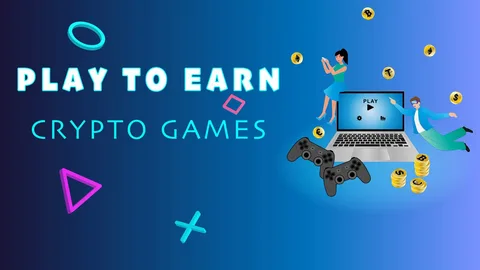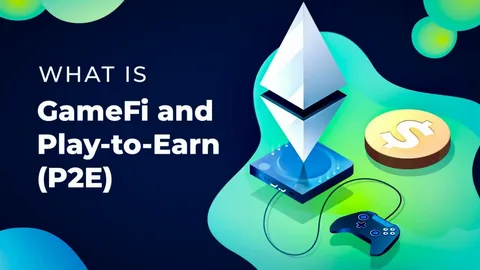Introduction
The gaming industry has always been at the forefront of digital innovation, but few trends have had as profound an impact as Play-to-Earn (P2E) games. These blockchain-based games allow players to earn real-world rewards in the form of cryptocurrencies or non-fungible tokens (NFTs) as they play, creating a new paradigm for the gaming experience. With the integration of crypto technology, the gaming industry is being transformed, offering players ownership of in-game assets and a more interactive, rewarding experience.
This post will explore how Play-to-Earn games are reshaping the crypto gaming industry by blending traditional gaming mechanics with decentralized finance (DeFi) and blockchain technology. We will delve into how P2E games work, their impact on players and developers, challenges they face, and the future of this emerging space.

The Rise of Play-to-Earn Games
Play-to-Earn games are a new breed of online gaming, where players can earn cryptocurrency or in-game tokens that can be traded, sold, or used within the game’s ecosystem. This concept is grounded in blockchain technology, which provides transparency, security, and decentralized ownership. These games have attracted millions of players globally, many of whom are looking to generate real income while enjoying a gaming experience.
The foundation of Play-to-Earn games lies in the integration of cryptocurrencies, making it possible for gamers to profit from their skills and time investment. Players typically earn rewards by completing tasks, engaging in battles, or achieving milestones in the game. These rewards come in the form of cryptocurrencies or NFTs that can be sold on decentralized exchanges.
Examples of Successful Play-to-Earn Games
Several P2E games have garnered significant attention and player bases. For example, Axie Infinity, one of the most popular P2E games, allows players to breed, trade, and battle virtual pets called Axies.
These Axies are NFTs that hold real-world value, and the game’s in-game currency, Smooth Love Potion (SLP), can be traded on major cryptocurrency exchanges. Decentraland, another leading game, offers players a virtual world where they can buy, sell, and trade virtual real estate and goods using cryptocurrency.
These early successes in the Play-to-Earn model have inspired a wave of new crypto games, each offering unique earning opportunities, gameplay mechanics, and ecosystems.
How Play-to-Earn Games Work
At the core of Play-to-Earn games is the concept of digital ownership, which is made possible through blockchain technology. Players can truly own the in-game assets they acquire, unlike in traditional games where items are owned and controlled by game developers. In P2E games, these assets can include NFTs, virtual land, or tokens that players can trade or sell on decentralized markets.
Blockchain and Cryptocurrency Integration
Most P2E games are built on blockchain platforms such as Ethereum, Binance Smart Chain, or Solana, allowing players to earn cryptocurrencies as rewards. These tokens can be used to enhance in-game experiences, such as purchasing new characters, upgrading weapons, or buying land, or they can be exchanged for fiat money or other cryptocurrencies on exchanges. For instance, Axie Infinity runs on the Ethereum blockchain and offers the ability to earn SLP tokens, which are then traded for Ether (ETH) or other cryptocurrencies.
The Role of NFTs in P2E Games
Non-fungible tokens (NFTs) play a critical role in many Play-to-Earn games. NFTs represent unique in-game items such as characters, weapons, skins, or virtual real estate. Each NFT is stored on the blockchain, ensuring that the item is truly owned by the player and cannot be duplicated or taken away.
This adds a layer of value to the gaming experience, as players can earn rare or unique items that hold real-world value. For example, in The Sandbox, a blockchain-based virtual world, players can create, buy, and sell virtual assets as NFTs, contributing to the in-game economy and generating real income.
Impact on Players and Developers
The Play-to-Earn model has brought significant changes to both players and developers, creating new opportunities and challenges within the crypto gaming industry.
Benefits for Players
For players, the appeal of Play-to-Earn games is obvious: they get paid to play. Gamers can earn tokens, trade valuable NFTs, and monetize their time and skills in a way that was previously not possible in traditional gaming.
For example, players in countries with lower average incomes, such as the Philippines and Venezuela, have turned to Play-to-Earn games like Axie Infinity as a source of income. The ability to earn real money through gaming has made P2E games highly attractive in these regions.
Furthermore, players have greater autonomy and control over their in-game assets. Since assets are stored on the blockchain, players are free to trade or sell their items without relying on the game’s developer or centralized entities. This contrasts with traditional games, where developers can shut down servers or change game rules, leaving players with nothing.
Opportunities for Developers
For game developers, Play-to-Earn represents a chance to innovate and create new types of games that are decentralized and player-driven. By building games on blockchain technology, developers can tap into the growing demand for crypto and NFT-based games, attracting a new generation of players interested in both gaming and earning income.
P2E games also allow developers to introduce new revenue models, such as transaction fees on trades, secondary sales of NFTs, or tokenized economies that benefit both players and developers.
Challenges Facing the Play-to-Earn Model
While Play-to-Earn games offer exciting new opportunities, they also face a number of challenges that could affect their long-term success in the gaming industry.
Scalability and High Transaction Costs
One of the major issues plaguing Play-to-Earn games is the scalability of the blockchain networks they rely on. Popular blockchains such as Ethereum often experience congestion and high transaction fees, making it difficult for players to engage in frequent transactions without incurring significant costs. Although layer-2 solutions and alternative blockchains such as Solana and Polygon aim to solve this issue, scalability remains a concern for the widespread adoption of P2E games.
Regulatory Uncertainty
Another challenge facing the crypto gaming industry is regulatory uncertainty. Governments around the world are still determining how to regulate cryptocurrencies and NFTs, and Play-to-Earn games fall into a grey area.
As these games often involve real-world financial transactions, there is a risk that they could face restrictions or bans in certain countries. Developers and players must navigate an evolving regulatory landscape that could have significant implications for the future of P2E games.
The Future of Play-to-Earn and the Crypto Gaming Industry
Despite these challenges, the future of Play-to-Earn games appears promising. As blockchain technology continues to evolve, and more players and developers enter the space, the P2E model is expected to become an integral part of the crypto gaming industry.
Mainstream Adoption
One of the most significant trends to watch is the mainstream adoption of Play-to-Earn games. As major gaming companies and developers start to explore blockchain technology, we may see the integration of P2E mechanics into more traditional games, bridging the gap between crypto enthusiasts and mainstream gamers. Additionally, improvements in blockchain scalability and lower transaction fees will likely drive further adoption.
Community-Driven Economies
Play-to-Earn games have the potential to create self-sustaining, community-driven economies. Unlike traditional games, where developers control the game’s economy, P2E games allow players to take an active role in shaping the in-game market. This decentralization of power and ownership could lead to the creation of vibrant, player-driven ecosystems where the community has a direct impact on the game’s development and success.
Conclusion: The New Frontier of Gaming
The emergence of Play-to-Earn games marks a significant shift in the gaming industry, offering players the ability to earn real-world rewards while engaging in virtual experiences. By integrating blockchain technology and cryptocurrencies, P2E games have introduced a new level of autonomy, ownership, and financial opportunity for players around the world. Although challenges such as scalability and regulatory uncertainty remain, the potential for Play-to-Earn games to reshape the crypto gaming industry is undeniable.
As the Play-to-Earn movement continues to grow, we can expect to see more innovations and opportunities in the gaming space. Are you ready to explore the future of gaming? Let us know your thoughts in the comments below!



